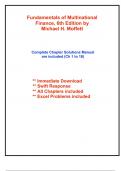Exam (elaborations)
Solutions for Fundamentals of Multinational Finance, 6th Edition Moffett (All Chapters included)
- Course
- Institution
Complete Solutions Manual for Fundamentals of Multinational Finance, 6th Edition by Michael H. Moffett, Arthur I. Stonehill, David K. Eiteman ; ISBN13: 9780136879411...(Full Chapters included Chapter 1 to 18)...1.Multinational Fin Mgmt: Challenges & Opportunities 2.The International Monetary Syste...
[Show more]



